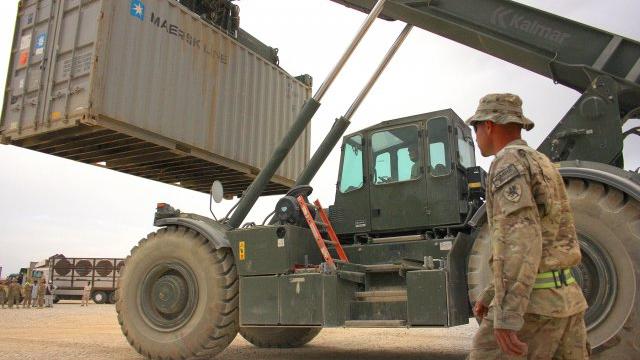NATO formally ended combat operations at the end of 2014, but the US military couldn’t just… leave. No, pulling out of Afghanistan was a massive operation in itself, one that took three years of planning and cost an estimated $US28 billion — just to get out.
Over at Fast Company, E.B. Boyd has written searing account about the logistics of leaving Afghanistan, putting the scale of the war in stark perspective.
After 13 years, the U.S. military had 62,000 shipping containers worth of gear spread out over 500 bases across the country. Just packing up everything would have been hard, but this was still an active combat zone, where IEDs still lurked and enemy fighters still attack. The equipment we didn’t take we couldn’t just abandon. Consider the MRAPs (“mine-resistant, ambush protected” trucks), many of which had to be dismantled by hand.
In yards elsewhere, the doomed MRAPs were torn down further. Workers pulled off their thick, blastproof windows. They removed the seats. They ripped out the classified armour. The bare shells were handed off to workers at a third yard, who methodically cut them up into scrap using plasma cutters in a process so secret that workers were told never to use the same pattern twice and photographs weren’t allowed. (They didn’t want enemies to learn where the weak parts were.)
Entire military bases also had to be renovated for new tenants — be it the Afghan army or police other government agency — lest they fall into Taliban hands and become “state-of-the-art fortresses” for the enemy.
This was also complicated by the fact that the military had done a crummy job of keeping track of what it brought to Afghanistan. Take the most basic of items, the shipping container. The military had to create an entire team dedicated to tracking down lost containers.
The military used them for transporting gear, including into Afghanistan. But in a country as infrastructure-starved as this one, they were quickly turned into structures. A shipping container could become a storeroom, an office, a dorm. They were used as walls, entry gates, and foundations for guard towers. In theory, units were supposed to record their containers in a centralized database. But the system wasn’t enforced well, and compliance was spotty…
We couldn’t leave without locating and disposing of all the containers — commercial and military. At the beginning of 2013, military databases said we had 108,000 containers in the country. But who could say for sure? One BCAT member at Shank told me he found a container on a base up north that was logged as being hundreds of miles away — in the Pakistani port of Karachi. The military was forced to create Mobile Container Assessment Teams whose sole job was to hunt down those containers. And yet, just this past November, a GAO report on the subject said the military’s ability to keep detention fees low was still “limited by inaccurate and incomplete data.”
There is much more in Boyd’s fantastic story in Fast Company, which is well worth taking time to read in full. The logistics of leaving Afghanistan are a lens for understanding the scale of our war there, however far away it may have felt to most Americans. Remember, we’re all paying for this. [Fast Company]
Picture: US Army
